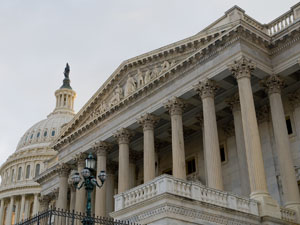Updated at 9:30 a.m. on January 2.
Legislation passed by Congress New Year’s Day to avert the dreaded “fiscal cliff” would stop a scheduled payment cut in Medicare physician payments. But hospitals, which have to bear a major part of financing for that “doc fix,” are not happy.
The bill would require that, over the next decade, hospitals pick up nearly half of the approximately $30 billion cost of stopping a 26.5 percent payment cut for Medicare physicians, scheduled to begin today.
The 26.5 percent reduction for doctors comes from a payment formula created in a 1997 deficit reduction law. For the first few years, doctors received modest pay increases. But in 2002, doctors reacted with fury when they came in for a 4.8 percent pay cut under that plan. Every year since, Congress has staved off the scheduled cuts.
The package would reduce hospital payments in two ways. First, it would cut $10.5 billion from projected Medicare hospital payments over 10 years for inpatient or overnight care through a downward adjustment in annual base payment increases. The Senate measure also would reduce Medicaid disproportionate share payments to hospitals by an additional $4.2 billion over the next decade. These cuts are on top of those made to hospitals as part of the 2010 health care law.
Groups representing hospitals said the new plans for reductions will hurt their ability to care for patients.
“While fixing the physician payment formula is essential, it should not be done by jeopardizing hospitals’ ability to care for seniors and their communities,” Rich Umbdenstock, president and chief executive officer of the American Hospital Association, said in a written statement.
Chip Kahn, president and CEO of the Federation of American Hospitals, also expressed dismay that hospitals funded much of the doc fix. “It is not in the best interest of patients or those who care for them to rob hospital Peter to pay for fiscal cliff Paul,” he said.
The American Medical Association said that the “last-minute action” is “a clear example of how the Medicare program is increasingly unreliable for physicians and patients.”
Dr. Jeremy Lazarus, president of the AMA, said “Congress’ work is not complete; it has simply delayed this massive, unsustainable cut for one year. Over the next months, it must act to eliminate this ongoing problem once and for all.”
The bill also would continue a number of Medicare policies known as “extenders.” Those extenders include a wide variety of policies, including special provisions for some low-volume hospitals and charges for ambulance and physical therapy costs.
Other items in the package that would finance the “doc fix” and Medicare extenders include rebasing bundled payments for end stage renal disease (saves $4.9 billion), implementing competitive bidding for diabetic test strips purchased in retail pharmacies (saves $600 million) and reducing risk-adjusted payments to Medicare Advantage plans ($2 billion).
In addition to the physician payment fix, the bill alters tax rates and delays a series of automatic cuts in federal spending, called “sequestration,” scheduled to go into effect Jan. 2. That includes a 2 percent reduction to physicians and other Medicare providers – including hospitals.
While seniors would see no changes in their benefits under sequestration, Medicare providers will face $11 billion in cuts through the end of the government’s fiscal year on Sept. 30.







